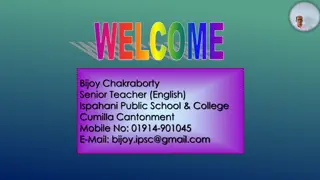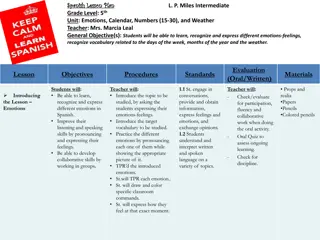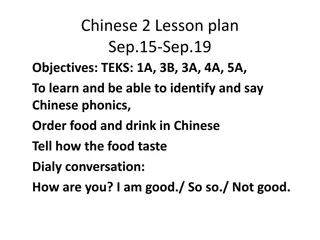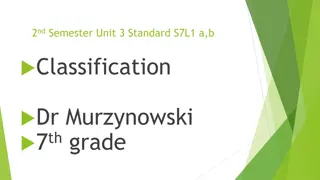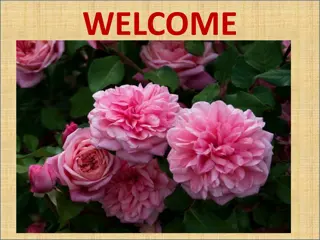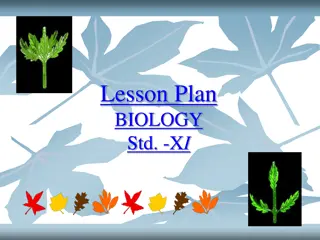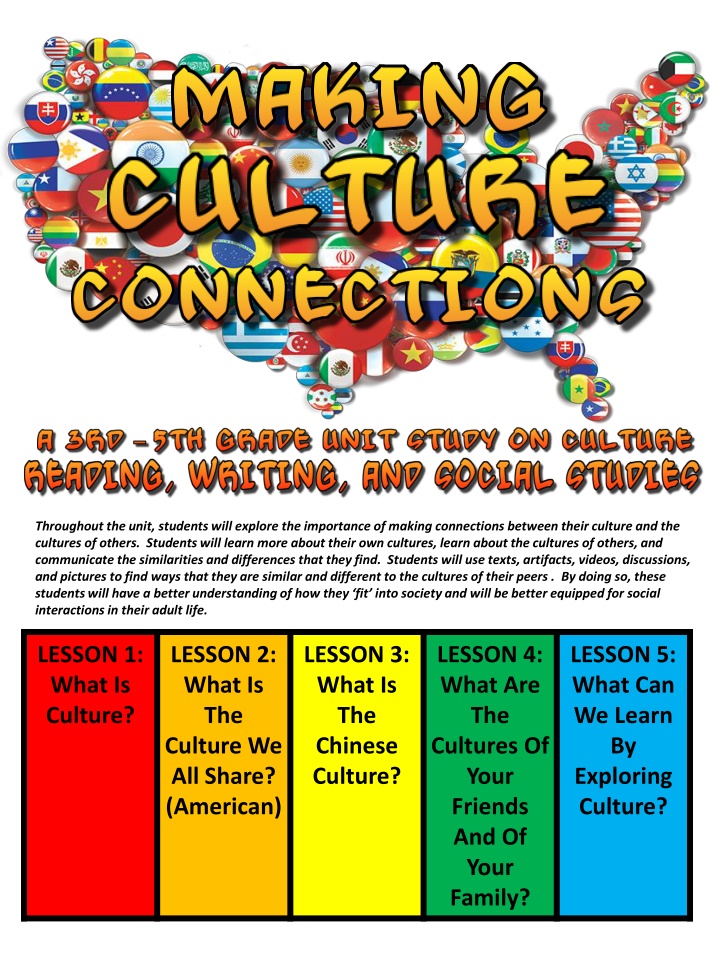
Making Culture Connections: Exploring Different Cultures in Education
Explore the importance of connecting cultures in education through lessons on American and Chinese cultures, as well as student-selected cultures. Utilize texts, artifacts, videos, and discussions to understand similarities and differences, enhancing students' social interactions and cultural awareness.
Download Presentation

Please find below an Image/Link to download the presentation.
The content on the website is provided AS IS for your information and personal use only. It may not be sold, licensed, or shared on other websites without obtaining consent from the author. If you encounter any issues during the download, it is possible that the publisher has removed the file from their server.
You are allowed to download the files provided on this website for personal or commercial use, subject to the condition that they are used lawfully. All files are the property of their respective owners.
The content on the website is provided AS IS for your information and personal use only. It may not be sold, licensed, or shared on other websites without obtaining consent from the author.
E N D
Presentation Transcript
Throughout the unit, students will explore the importance of making connections between their culture and the cultures of others. Students will learn more about their own cultures, learn about the cultures of others, and communicate the similarities and differences that they find. Students will use texts, artifacts, videos, discussions, and pictures to find ways that they are similar and different to the cultures of their peers . By doing so, these students will have a better understanding of how they fit into society and will be better equipped for social interactions in their adult life. LESSON 1: What Is Culture? LESSON 2: What Is The Culture We All Share? (American) LESSON 3: What Is The Chinese Culture? LESSON 4: What Are The Cultures Of Your Friends And Of Your Family? LESSON 5: What Can We Learn By Exploring Culture?
UNIT PLAN: MAKING CULTURE CONNECTIONS Jeromie Heath Alki Elementary Subjects: Topic: Culture Studies Reading/Writing/Social Studies Study American, Chinese and another culture and explore the similarities and differences among them. We do this by investigating Daily Life, Expression, and Customs of each culture by using texts and artifacts. We use what we learned to understand ourselves and each other a little better. Over- view: Artifacts from different cultures Non-fiction texts of different countries/cultures Graphic Organizers Videos (of cultures) Materials: Students will use nonfiction/fiction texts, videos, artifacts, and conversations to explore 3 cultures (American, Chinese, and another of their choice) and compare/contrast them. Objectives: Full detailed list on next page (See Learning Targets) 1. Discuss what culture is Daily Life, Expression, Customs : A. Do the culture sort, hold a conversation, and do a student talk 2. Fill out graphic organizers about American culture using texts, conversations, & artifacts A. Fill out the Daily Life Organizer with whole group B. Have kids work in pairs to fill out Expressions and Customs C. Read American Culture: As told by 5th grade class with students students will add more info to their organizers D. You can choose to have students write a paragraph for each section 3. Fill out graphic organizers about Chinese culture using texts, conversations, videos & artifacts A. Read Chinese Culture book and watch videos one at a time with class for each section B. As you teach, read, and discuss each video segment/book page- students also look at and explore artifacts C. Students add facts to their graphic organizer 4. Complete a compare/contrast of American and Chinese culture A. Use the fact sheets to complete the compare/contrast organizer B. Students share their information with the class 5. Fill out graphic organizers about a selected culture (may be a totally separate culture or the culture of the student) using texts, conversations, & artifacts A. Students collect texts, research online and use videos to fill out a graphic organizer on their own culture or choose one that is unfamiliar to their culture B. Students either bring in artifacts or pictures of their artifacts (possible technology connection) 6. Complete a compare/contrast of Selected Culture and American culture A. Students fill out the organizer and then do a writing that shares what they learned about culture and how learning about cultures can improve your life 7. Discuss (and write about) how learning different cultures improves communication and understanding of the world around you Procedures:
UNIT PLAN: MAKING CULTURE CONNECTIONS (continued) Completion of graphic organizers for each lesson A short writing for each lesson- paragraph writing A longer writing to end the unit Presentations of different cultures Assessment: Evaluation/ Could expand this unit to include: Comparisons of fictional literature (ie: folktales, fairytales, and myths from the different cultures) Geography and mapping of major cities and/or how topography effects a culture Extension into math to discuss comparisons of populations of countries Research online using valid websites Interdisciplinary Possibilities/ Connections Extension The countries and activities in this unit can be adjusted depending on the availability of the artifacts or texts. You could supplement different cultures depending on your students cultural background or artifact availability. Reflections: Tips And You can alter or modify the assignments to fit your students needs. For example, in place of one paragraph writing, you could do 3 or 4. Or you could extend the sources to include multiple texts or higher level texts. Videos taken in China/Taiwan Interviews from Tom, Liz, Troy, and visits/interviews with families Consulted Sources
LEARNING TARGETS (Objectives) I can understand and explain the concept of what a culture is and why it is important. I can describe the different elements that make up a culture LESSON 1: What Is Culture? What Is The Culture We All I can explore daily life in America by using text, artifacts, and conversations. I can read, analyze, and sort information (about culture) on a graphic organizer. I can express my thoughts on daily life in America in a clear and organized paragraph. I can use artifacts, texts, and conversations to explore American customs and expression. I can research and sort information on a graphic organizer. Share? (American) LESSON 2: I can explore daily life in China by using text, artifacts, and conversations. I can read, analyze, and sort information (about culture) on a graphic organizer. I can express my thoughts on daily life in China in a clear and organized paragraph. I can use artifacts, texts, and conversations to explore Chinese customs and expression. I can research and sort information on a graphic organizer I can demonstrate what I have learned through my research on Chinese customs and expression by writing clear and organized paragraphs I can compare and contrast American daily life and Chinese daily life by using what I learned in my research. I can compare and contrast American customs and Chinese customs by using what I learned in my research. I can compare and contrast American expression and Chinese expression by using what I learned in my research. What Is The Chinese Culture? LESSON 3: Friends And Of Your I can read and organize facts about daily life, customs, and expression of another culture using texts, videos, artifacts, and conversations. I can compare/contrast daily life, customs, and expression of American culture and another culture. Cultures Of Your What Are The LESSON 4: Family? What Can We I can use the research that I have collected on China, America and another country to discuss and write about how cultures are the same and different. I can explain what culture is and how it helps people understand each other. LESSON 5: Exploring Learn By Culture?
Daily Life What pets do you have? Who lives in your house? How often do you visit family? How does your family express care/love? What activities do you do with your family? How do you get rewarded for good behavior? How do you get punished for bad behavior? Family How long is your school day? School year? What do you learn in school? Subjects? Do you have music class? Do you have PE? Do you have tests? Do you have wall ball? Do you have assemblies? Do you pay a lot of money for college? Do you speak English all day at school? Do you learn art at school? What are your school rules? Can you talk to your classmates during lessons? School What kind of food do you eat every week? Eat most often? What kind of food do you have but you don t like? What is your favorite food? What foods are only found in this area? What foods are eaten only on special occasions? What foods are considered rare? Do you have forks? How often do you eat junk food? Food Where do you spend the most time during the day besides school? What activities do you do with your friends? What sports do you play? What do you do for fun? What video games or outside games do you play? What kind of hobbies do you have? What kind of movies do you watch? TV shows? What kind of technology do you use for fun? What kind of board games do you play? Entertainment What clothes do you wear regularly? What clothes do you wear only for special occasions? What do you wear to School? Play? Do you have tattoos? Do you wear jewelry to school? Can you wear makeup? At what age? Where are you allowed to wear it? Clothing
Expression What are some basic rules of writing? Capitals? Grammar? Paragraphs? How many letters are in your alphabet? What kind of writing do you do? When do you write? Language What languages do you speak? What language is spoken the most? Are there different things you say to friends than to family? What is considered very rude/bad? What do you consider to be very polite/good? Are there things you say to adults? What are polite words you use? What is considered rude when talking? What kinds of art are popular? What kind of art do you like to do? What kind of art is the most fun? Art What kind of music is popular? Is there a certain type of music played at special occasions? What kind of music do you play (instrument)? Are there instruments that are specific to this culture? What kind of dance is popular? Why do people dance? When do people dance? Music/ Dance
Customs What holidays do you celebrate? What do you do on those holidays? Are there holidays that are more important than others? What things do you celebrate? How do you celebrate them? What is your favorite celebration? Holidays and Celebrations What monuments are there and why were they created? What buildings are important? What kind of historical artifacts are there? Wonders What is considered lucky or unlucky? What are some things that are considered very good (things you value)? What are some religious traditions you have? Beliefs





